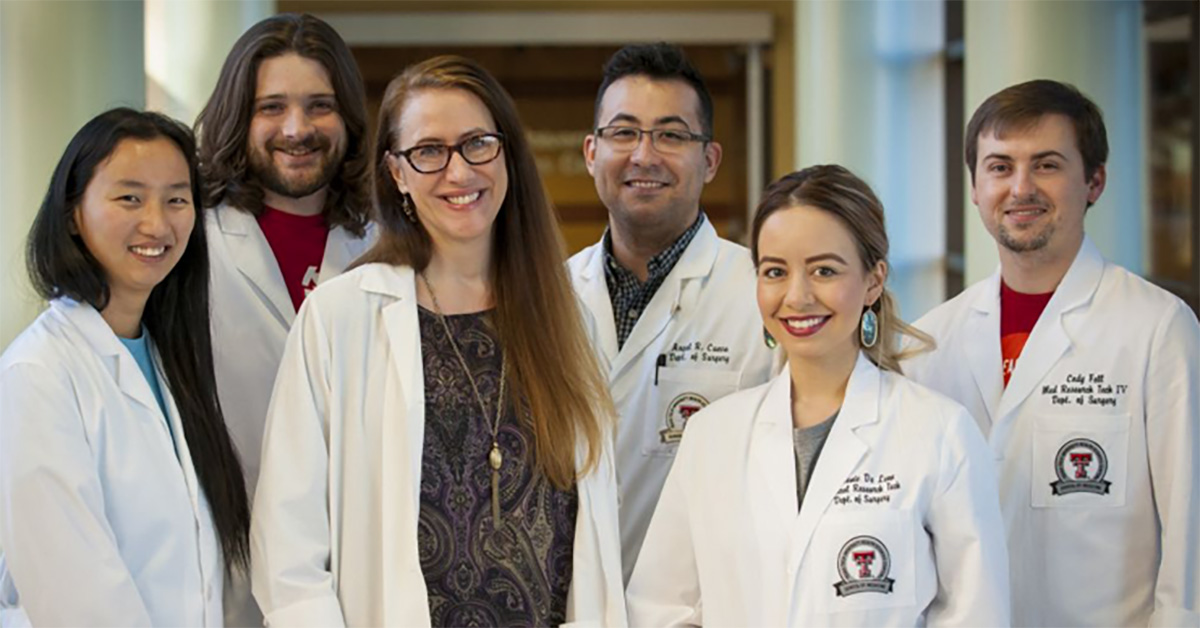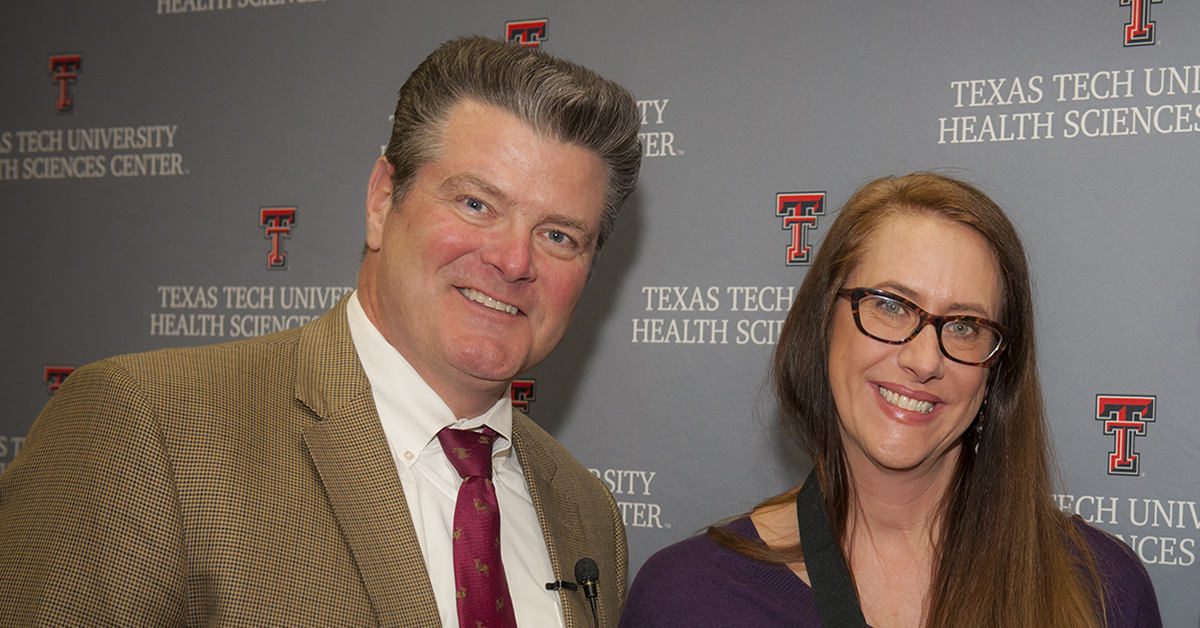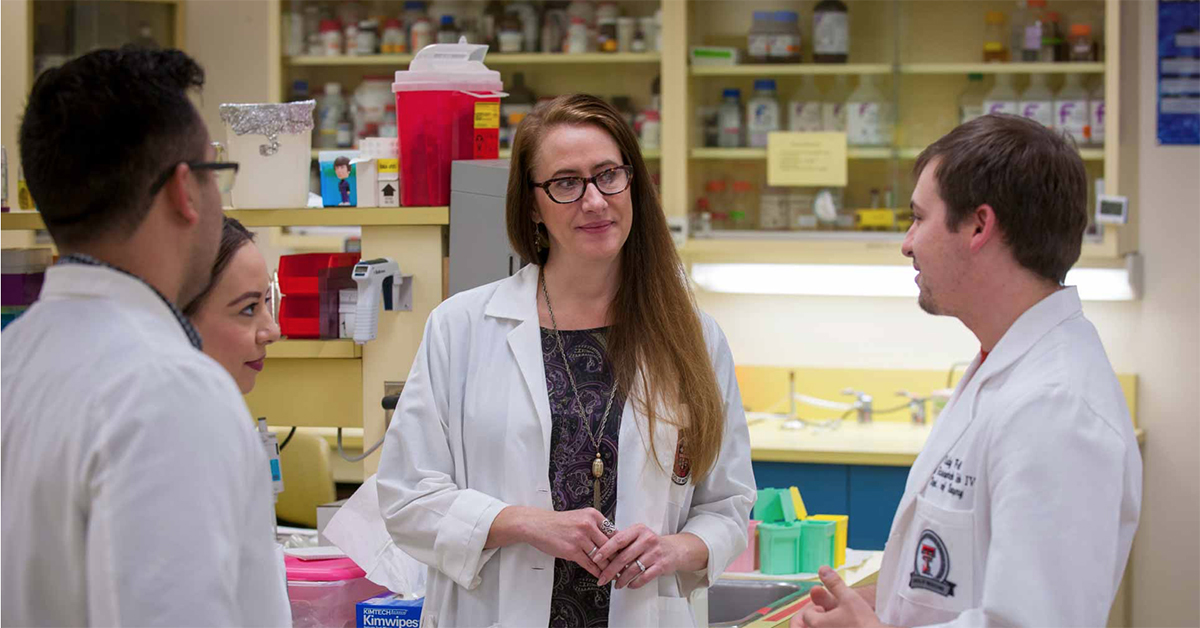Researcher's quest for new weapons to fight nature's nastiest superbugs

Kendra Rumbaugh, center, with research students at TTUHSC.
Kendra Rumbaugh engages in a daily battle against tiny creatures we can’t see that hold the power of life and death over us.
“Microbes are invading us,” said Rumbaugh, a microbiologist at the Texas Tech University Health Science Center (TTUHSC). “You have to have respect for the enemy because microbes are more advanced in evolution.”
Rumbaugh and her team of investigators fight that battle in the research laboratory at the School of Medicine’s Department of Surgery, where she is a professor.
She’s also an international expert in infection and wound treatment which is critical for surgical and burn patients, diabetics and amputees. Working with researchers overseas, she’s advancing our knowledge of microbial defenses to develop more effective treatments for wound care.
In honor of her career of achievement, Rumbaugh was awarded the Chancellor’s Council Distinguished Research Award, the most prestigious honor given to faculty members throughout the Texas Tech University System.

TTUHSC President Tedd L. Mitchell, left, and Kendra Rumbaugh during a campus ceremony on Jan. 25, 2018.
She received $5,000 and a medallion for her excellence, funded by annual membership gifts to the Chancellor’s Council — a giving society that supports the priorities of the chancellor by impacting student lives through scholarships, recognizing faculty achievement and encouraging excellence across all four system universities.
“I have many colleagues doing spectacular work,” Rumbaugh said, “and I have so much respect for so many of them. I think it is an incredible compliment to be singled out for this award and know that the administration appreciates you.”
Her research to fight drug-resistant infections could have a profound impact on our healthcare system.
“We have people dying all the time because we have infections that can’t be treated,” said Rumbaugh, but she is optimistic. “We are close to developing a new therapy and seeing a positive outcome.”
‘I have to do that’
Rumbaugh was born in New Mexico and remembers always wanting to be a scientist.
“I always liked biology, nature and space exploration,” she said.
It was when she went to the University of Texas at El Paso that she became enthusiastic about microbiology. “I had a fantastic teacher in Introduction to Microbiology, and I told myself, ‘I have to do that.’”
She followed the path to a Ph.D. in medical microbiology at Texas Tech University Health Sciences Center. After receiving a post-doctoral training fellowship from Cystic Fibrosis Research Inc., she moved to San Francisco to work in the Wiener-Kronish laboratory at the University of California San Francisco.
Eventually, she returned to Lubbock, where she is now a tenured professor in the Department of Surgery with joint appointments in the Department of Cell Biology and Biochemistry and the Department of Immunology and Molecular Microbiology.

Kendra Rumbaugh, center, listens to medical students in her research lab.
The National Institutes of Health, the American Diabetes Association and the Department of Veterans Affairs have all consulted Rumbaugh on wound treatment. She is also co-founder and previous president of the West Texas Association for Women in Science and president of the Texas branch of the American Society for Microbiology.
Breaking down biofilms
Rumbaugh’s research focuses on the drug-resistant defenses microbes have developed and possible solutions for disabling them.
“Microbes can change themselves, which is a strategy to protect themselves from a harsh environment, whether it’s a sink or a riverbed,” Rumbaugh said. They may slow down their metabolism and, in doing so, create a greater tolerance to antibiotics.
“Bacteria may secrete a slime coat or a biofilm after they colonize a wound,” Rumbaugh added, explaining that this is one major reason chronic infections, such as diabetic foot ulcers, are difficult to treat.
A biofilm is a slimy, sugar-rich structure that protects bacteria from the body’s immune response and anti-microbial agents, making them up to 1,000 times less susceptible to extermination. A chronic wound may contain dozens of microbial species, and little is understood about how they work together to resist treatment.
According to Rumbaugh, as many as 85 percent of bacterial infections are shielded by biofilms, which are protecting them from therapeutic drugs. Her objective is to develop agents that can break down the biofilm structures and cause them to collapse. That would increase the effectiveness of existing antibiotics and reverse the antibiotic resistance plaguing health care.
“We have developed several in vitro and in vivo wound models with which to test experimental antimicrobials and anti-biofilm agents,” Rumbaugh said of her lab at TTUHSC.
In this quest, she often collaborates with researchers overseas.
“We have extensive experience in working with companies and academic collaborators to test the efficacy of new therapeutics,” she said.
“There is a strong network of biofilm research in Europe. Europeans take this threat
more seriously. There is more interest in developing new drugs.”
The European response includes more government support for drugs aimed at resistant
strains.
“I work with a lot of companies — small pharmaceuticals — that don’t have their own research division. We’ve worked with a dozen or so in Europe that target biofilm,” Rumbaugh said.
Medieval Medicine
Rumbaugh’s research team and their European counterparts have even reached back to Medieval times for a potential cure for one of the most serious infections we face.
The novel opportunity for collaboration presented itself when researchers at Nottingham University in England were approached by an academic in the Medieval Studies department about a 1,000-year-old recipe from Bald’s Leachbook. They turned to Rumbaugh and Texas Tech University Health Sciences Center for their expertise in testing antimicrobial compounds.
The millennium-old Bald's Leechbook, left, contains a recipe, right, for eye salve that has proven effective against modern bacteria, including MRSA.
Bald’s recipe for eye salve was probably intended to treat a sty, which is caused by staphylococcus aureus bacteria infecting in an eyelash follicle. But the same staph bacteria also cause other severe and persistent infections including methicillin-resistant Staphylococcus aureus strains, or MRSA, that are associated with the chronic wound infections that Rumbaugh studies.
The ointment was made of garlic, leek, wine, and oxgall — bovine bile — combined in a brass vessel and left for nine days. When investigators tested the effect of Bald’s eye salve on staph, they found it was 90 percent effective in treating MRSA infections. It also significantly reduced the number of viable cells in biofilms.
According to Rumbaugh, even in its first formulation the feudal-era remedy was more effective than vancomycin, currently the first-line treatment for MRSA infections. Finding the right formula could create a new antibiotic for hospital use that would save lives.
“It’s important to understand the ancient power and adaptability of microbes,” Rumbaugh said. “We won’t be able to conquer them, but we can fight them off.”
Related Stories
Celebrating Veterans: TTUHSC’s General Martin Clay’s Legacy of Service and Leadership
From his initial enlistment in the Army National Guard 36 years ago to his leadership in military and civilian health care management roles, Major General Martin Clay’s career has been shaped by adaptability, mission focus and service to others.
Texas Tech University Health Sciences Center School of Nursing Named Best Accelerated Bachelor of Science in Nursing Program in Texas
The TTUHSC School of Nursing Accelerated Bachelor of Science in Nursing (BSN) program has been ranked the No. 1 accelerated nursing program in Texas by RegisteredNursing.org.
TTUHSC Names New Regional Dean for the School of Nursing
Louise Rice, DNP, RN, has been named regional dean of the TTUHSC School of Nursing on the Amarillo campus.
Recent Stories
TTUHSC Cancer Researcher Honored by National Academy of Inventors
C. Patrick Reynolds, M.D., Ph.D., director of the School of Medicine Pediatric Cancer Research Center at TTUHSC, has dedicated his life as a researcher to developing treatments for childhood cancers.
TTUHSC School of Nursing Celebrates 10 Years of the Veteran to BSN Program
The TTUHSC School of Nursing recognized the 10-year anniversary of the Veteran to Bachelor of Science in Nursing (VBSN) program during the fall 2025 commencement ceremonies held Dec. 13 in Lubbock, Texas.
TTUHSC Dean to be Inducted into the National Academies of Practice as Distinguished Fellow
Gerard E. Carrino, Ph.D., MPH, dean of the TTUHSC Julia Jones Matthews School of Population and Public Health, will be inducted into the National Academies of Practice (NAP) as a Distinguished Fellow of the Public Health Academy.
